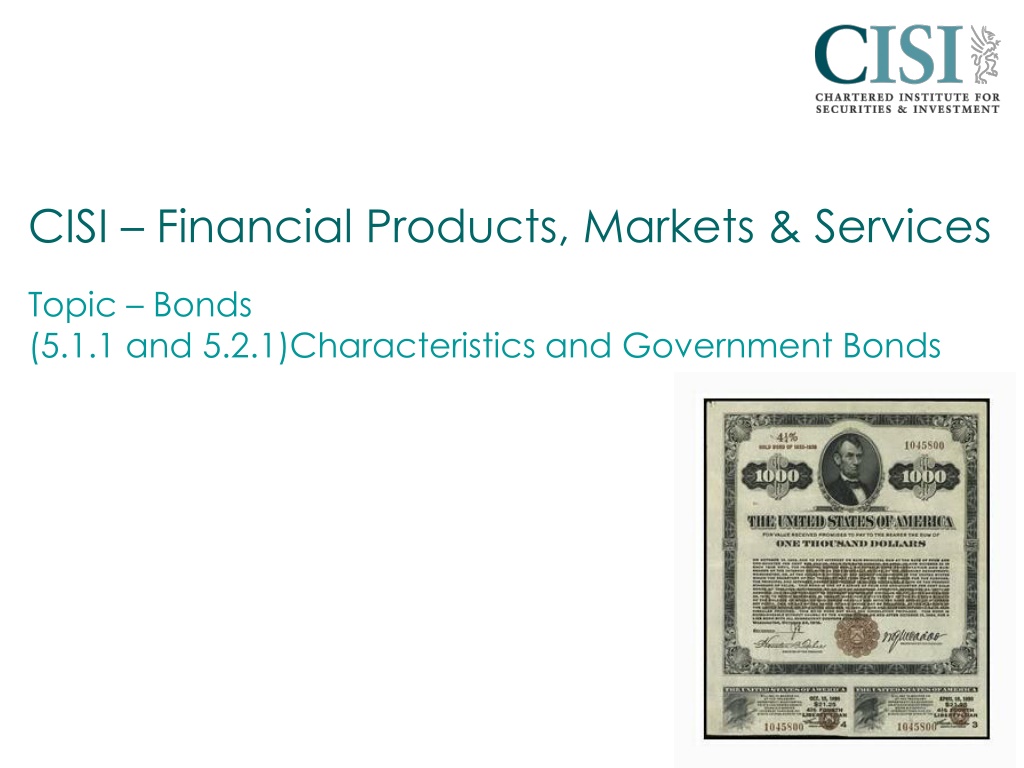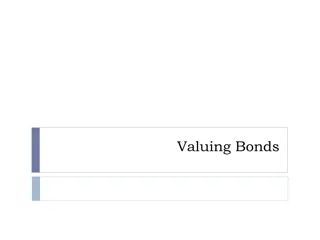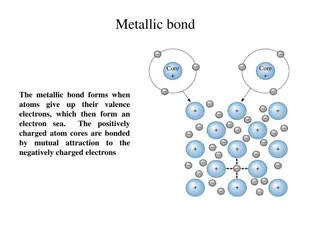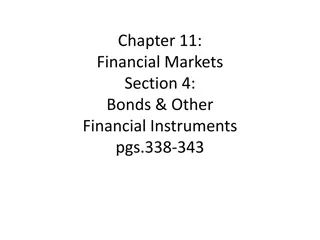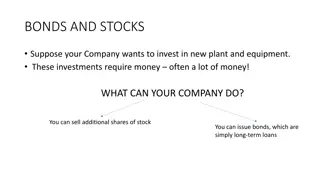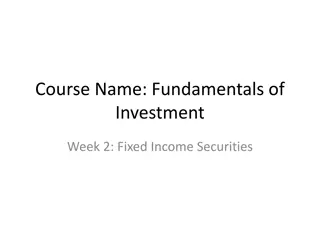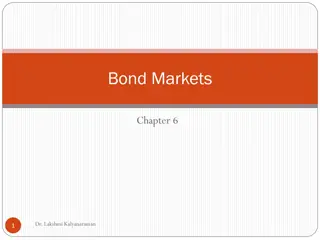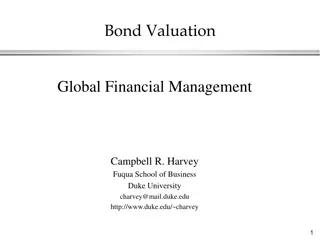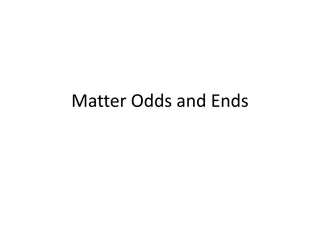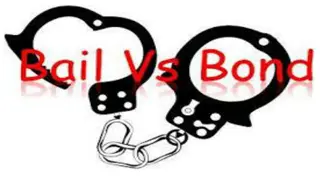Understanding Bonds: Characteristics, Issuers, and Investment Insights
Bonds are financial instruments representing loans, allowing companies and governments to raise funds. This article explores the characteristics of bonds, including tradeability, issuer profiles, terms like face value and coupon rate, and the importance of bonds in investment portfolios.
Download Presentation

Please find below an Image/Link to download the presentation.
The content on the website is provided AS IS for your information and personal use only. It may not be sold, licensed, or shared on other websites without obtaining consent from the author. Download presentation by click this link. If you encounter any issues during the download, it is possible that the publisher has removed the file from their server.
E N D
Presentation Transcript
CISI Financial Products, Markets & Services Topic Bonds (5.1.1 and 5.2.1)Characteristics and Government Bonds cisi.org
What are bonds? A bond is, very simply, a loan that is represented by an IOU (I owe you). If a company wants to borrow some money to enable it to expand, it could: a) b) Borrow it from a bank, or Issue bonds instead. With bonds, investors typically lend money to the company in return for: 1. The promise to have the loan repaid on a fixed future date and 2. To receive a series of interest payments cisi.org
Issuers of bonds Listed Companies Purpose of issuing bonds: Governments Purpose of issuing bonds: 1. Fund expansion and finance investment 1. Finance spending and investment 2. Generally cheaper and fewer restrictions compared with borrowing from a financial institution 2. Bridge the gap between their actual spending and their income they receive (taxes and other receipts) 3. Issuing bonds does not effect ownership When tax revenues are a lot less than government spending issuance of government bonds are high Major issuers: Major issuers: Most of the corporate bonds are issued by listed companies, such as the large banks and other large corporate organisations like McDonald s. Western governments e.g. UK, USA, Germany and France - the volume of government bonds in issue is very large. The term corporate bond is usually restricted to longer-term debt instruments, with a redemption date that is more than one year away at the point of issue. Bonds form a major part of the investment portfolio of many institutional investors (such as pension funds and insurance companies). cisi.org
Characteristics of bonds Bonds are also known as: Bonds are tradeable instruments: Loan stock Debt instruments Fixed interest securities The investor in a bond could sell that bond onto another investor without the need to refer to the original borrower Issuer in this case ABC plc is a company promising to repay the amount Terminology ABC plc will pay: Nominal/Face Value/Par value or principal This is the original value of the bond - what the original investor paid for it and the amount on which the interest is calculated 10,000 6 year Maturity or Redemption date The date at which the bond matures and the nominal value is paid back to the owner 7% Coupon The annual rate of interest paid to the owner, based on the nominal (face value) cisi.org
Characteristics of bonds Tradeable Remember that bonds can be sold on to somebody else this can be done without the knowledge of the original borrower. They are tradeable financial instruments. What does this mean? A bond will not always trade at its nominal value For example....... BUT Looks to sell the bond after 2-years New buyer reviews the situation New buyer will only pay 9,500 for the bond. They keep the bond until maturity when they receive the 10,000 nominal back. The 500 difference is the compensation for the uncompetitive 7% coupon Interest rates have gone up in the 2- year period The 7% coupon rate may no longer be competitive Original investor pays 10,000 for the bond (nominal) with a coupon of 7% cisi.org
Government bonds UK government bonds are known as gilts. This dates back to the days when the physical certificates were issued with a real goldor gilt edges to them, so they became known as gilts or gilt-edged stock . Bonds are issued on behalf of the UK government by the Debt Management Office (DMO). The total amount of new gilts issued is called the gross amount and the total amount less redemptions is the net amount. The chart also shows the percentage of GDP represented by the total of gilts in issue. cisi.org
Characteristics of a typical UK Government bond Redemption date The year in which the stock will be repaid. Repayment will take place at the same time as the final interest payment is made. The amount repaid will be the nominal amount of stock held; that is, 10,000 Stock UK Government bonds are named by their coupon rate and their redemption date 5 PER CENT TREASURY STOCK, 2025 Price the convention in the bond markets is to quote prices per 100 nominal of stock. So, in this example, the price is 101.25 for each 100 nominal of stock. Repayable at par on 7 December 2025 Interest payable half-yearly on 7 June and 7 December Price 101.25 Value 10,125.00 10,000 *** Coupon Nominal Value The annual rate of interest is quoted gross (before the deduction of any tax that might be payable) and for UK government bonds it is normally paid in two separate and equal half-yearly interest payments made 6 months apart The amount of stock purchased - not necessarily the same as the amount invested or the cost of purchase. This is the amount on which interest will be paid and the amount that will eventually be repaid. nominal amount of stock x current price. cisi.org
Types of government bonds: Conventional bonds 6% Treasury stock 2028 Has a SINGLE repayment date Carry a FIXED coupon It is conventional bonds that represent the majority of government bonds in issue. cisi.org
Types of government bonds: Index-linked bonds 2% Index-linked stock 2020 Specified redemption date Specified coupon BUT Both the coupon and the redemption amount (Nominal) are increased (uplifted) by the amount of inflation. Coupon uplift calculated between the interest payment date and the bond issue date Nominal uplift adjusted upwards to reflect inflation between the bond s issue date and redemption date. Who do they appeal to? Investors worried about inflation - provides extra protection when inflation is uncertain Long-term investors such as pension funds - like to know that the returns will maintain their real value after inflation so that they can meet their obligations to pay pensions. cisi.org
Types of government bonds: Dual-dated bonds 6% Treasury loan 2028-2032 Carry a FIXED coupon Has TWO DATES BETWEEN which repayment can be made The decision as to when to repay will be made by the government and will depend on the prevailing rates of interest at that time. What is the advantage? It gives more flexibility for a government but can be unpopular with investors - in the case above, the government had the option of repaying the bond within the four-year period. If.... In 2028, interest rates fall to below 6% The government repays the 6% Treasury stock 2028-2032 The government issues new bonds at a lower coupon rate, saving them money in interest payments cisi.org
Types of government bonds: Irredeemable/Undated bonds 3% War loan Has NO Carry a FIXED coupon repayment date Also known as perpetual or undated stocks Issued to help government expenditure in World War I Investor appeal or lack of ....... a) Lack of a certain repayment date is unattractive to investors. b) The government does repay a small amount of its undated stock each year using a mechanism called a sinking fund c) Investors can be selected by ballot and their undated stock will be repaid at nominal value. cisi.org
Gilt Strips STRIP stands for Separate Trading of Registered Interest and Principal. 6% Treasury stock 2018 Maturity 07.06.18 Coupon 1 07.06.15 Coupon 2 07.12.15 Coupon 3 07.06.16 Coupon 4 07.12.16 Coupon 5 07.06.17 Coupon 6 07.12.17 Nominal repaid 3% 3% 3% 3% 3% 3% Stripping a gilt refers to breaking it down into its individual cash flows which can be traded separately as zero-coupon gilts. As seen above, a three-year gilt will have seven individual cash flows: six (semi-annual) coupon payments and the final maturity repayment. cisi.org
